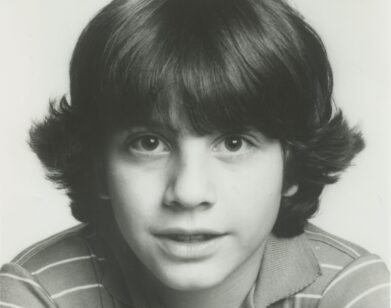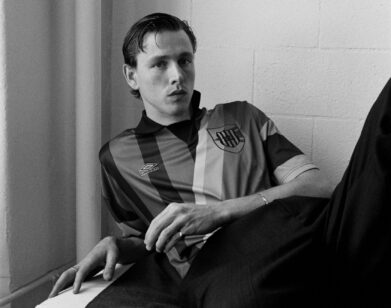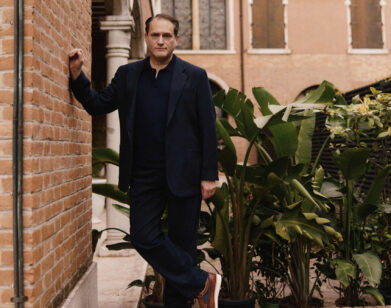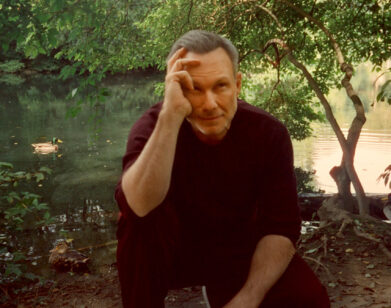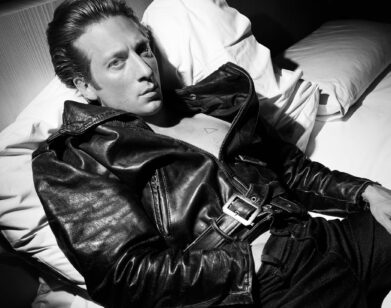Joshua Oppenheimer and the Atrocity Exhibitionists
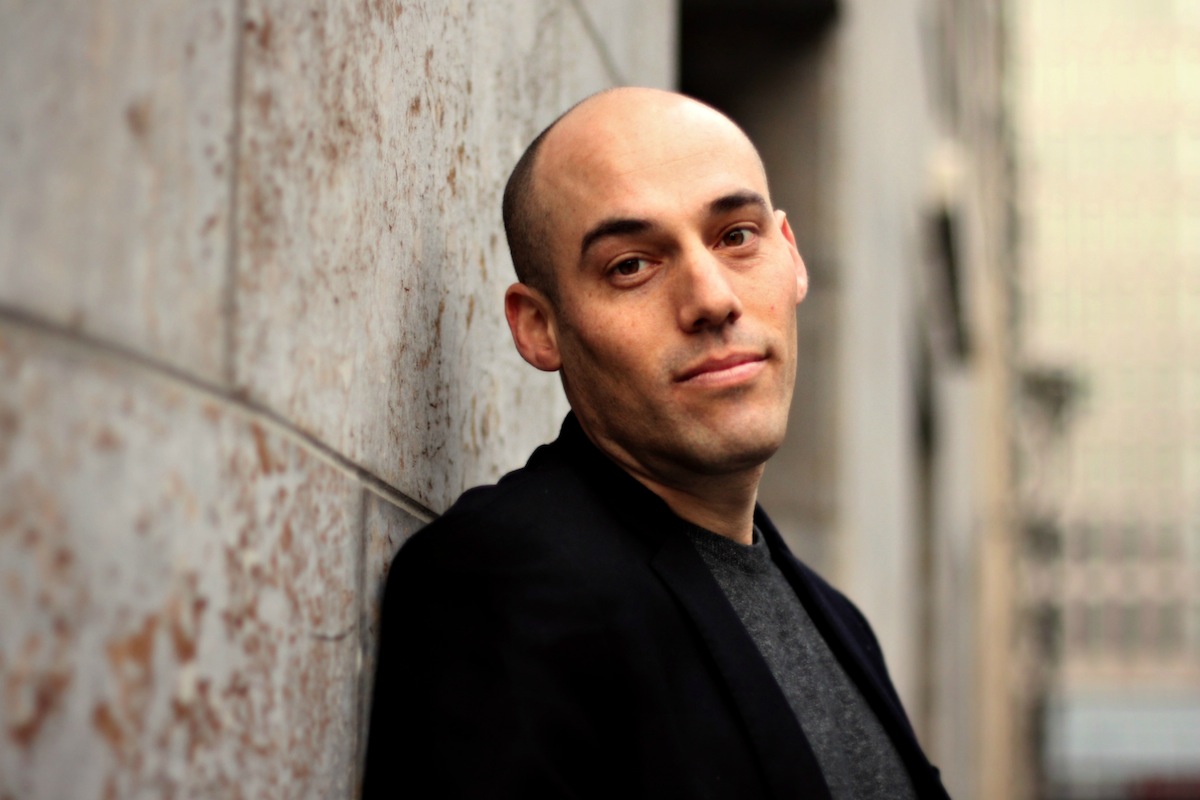
ABOVE: JOSHUA OPPENHEIMER. IMAGE COURTESY OF OLIVER CLASPER/DRAFTHOUSE FILMS
Imagine an alternate reality where the Nazis won World War II and continue to celebrate their victory and boast about the Holocaust. Such is the case in modern-day Indonesia, where paramilitary leaders openly discuss past killings on national television. In his new film, The Act of Killing, documentarian Joshua Oppenheimer follows the perpetrators of the 1965 genocide as they willingly reenact their crimes—playing both themselves and their victims.
Over the course of the movie, Oppenheimer focuses on Sumatran death squad leaders Anwar Congo and his friends Adi Zulkadry and Herman Koto. Before the murders, Anwar and Adi had been gangsters who made their money scalping black-market movie tickets. As big fans of Hollywood, Anwar and Herman recreate and relive the atrocities they committed more than 40 years earlier in the style of their favorite genre films. The results are lavish, wholly surreal portrayals of the murders by the very people who perpetrated them. “The method and the form was not a lure to get them to open up,” says Oppenheimer. “Rather it was a response to their openness and an attempt to understand the nature and the function of it.”
Through Oppenheimer’s astounding tactics, the audience is given an intimate window into the nature of genocide and the far reaches of human atrocity. “I was trying to understand how these men imagine themselves,” says Oppenheimer. By following Anwar and Adi, Oppenheimer displaying both the humanity and horror of Indonesia’s unpunished, often unrepentant killers. While Oppenheimer’s aim is clearly to shed light on the unknown massacres of the ’60s and oppressive political climate of modern Indonesia, he also asks the audience to become uncomfortably intimate with his subjects. The result is a searing portrayal of denial that isn’t as clear-cut as it would seem. As Oppenheimer says in our interview, “We are much closer to the perpetrators than we’d like to think.”
NATHAN REESE: Let’s go back to the inception of the film. Can you take me through how it all began?
JOSHUA OPPENHEIMER: I began this work in a community of survivors trying to make a film about what had happened—they’d asked me to make it. In 2001, I’d made another film, [The Globalization Tapes], with them about their effort to organize a plantation workers union where unions had been illegal. The women workers were spraying herbicide, which was destroying their livers. They were poisoning themselves and dying in their 40s. It turned out that their biggest obstacle for organizing was fear, because their parents, aunts, uncles, grandparents, had been in a plantation workers union until 1965, and had then been accused of being Communist sympathizers. They had been put in concentration camps during the genocide and had then been dispatched out by the military dictatorship and killed by civilian death squads. They were afraid, of course, that this could happen to them again if they organized a union because, more or less, these same men were still in power.
REESE: How did investigating the unions lead you to the men responsible for the genocide?
OPPENHEIMER: To show their struggles to organize a union, we had to talk about what they were afraid of, because that was their main obstacle. In talking about that, it turned out that we were under surveillance and the military would come and stop us. Meanwhile, I was being entrusted with these little missions by them to interview their neighbors who were involved with the killings to see if I could find out how their relatives had been killed. In stark contrast to the survivors who were being prevented from talking, the perpetrators were boasting—much like Anwar in the first scene, where he shows how he killed with wire. I was getting this kind of boastful openness from the perpetrators.
REESE: What was your reaction to seeing these men bragging about their atrocities?
OPPENHEIMER: Over the course of a few weeks at the end of 2001, early 2002, it was as though I was realizing I’d come to Germany 40 years after the Holocaust to find the Nazis still in power. But unlike the Holocaust, nobody really knew about this. As I dug deeper, it turned out that the West had supported the killings, so the killers were shameless in talking about the killings because they thought the world had supported them. Also, because they were insisting to themselves, rather desperately it turned out, that what they did was justified. So there was this kind of insistence or assertion of impunity in the boasting.
REESE: Why did you feel that you needed to continue to investigate the killers?
OPPENHEIMER: After making this first film about the plantation workers, I kept going back. We kept having trouble filming with the survivors. It was scary for the survivors, but the survivors and the broader Indonesian rights community said, “You must not stop. You’re onto something terribly important.” Because I started this work with plantation workers that were simply trying to organize a union, I recognized that this was not an extraordinary situation. Indeed, everything we buy is haunted by the suffering of people who work under similar cases. In all cases, there has been mass political violence, the perpetrators have won, and in their victory has built regimes of fear that are so severe that people are unable to get the human cost of the things they make incorporated into the price tags that we pay; we depend on the reality of The Act of Killing for our everyday living.
REESE: How were you led to Anwar and the rest of the subjects covered in the film?
OPPENHEIMER: We talked about how we could continue, and then one of the survivors, a woman whose aunt was killed, said, “Continue to film the perpetrators. They’ll not only tell you what happened”—which was not known and had never been documented in this part of Indonesia—”[but] people will see in their boasting exactly why [we] are afraid and the nature of their regime.” So I filmed every perpetrator I could find, starting with my next-door neighbor, asking everybody who they could introduce me to. I worked my way across the region up the chain of command. It was not a casting process. I was not looking for Anwar, or the right main character. I was trying to document first what happened, and then trying to understand the nature of the boasting, the nature of their openness in the present. Why are they boasting? For whom are they boasting? How do they want to be seen? How, ultimately, do they see themselves? I was trying to understand the nature of that regime.
REESE: How did you develop the method of asking the perpetrators to act out their crimes like Hollywood films?
OPPENHEIMER: As my question shifted from what happened, which I was trying to grapple with at the beginning, to become more contemporary, so too did I start developing this method. I said to everyone I filmed, from the 15th or 20th person (Anwar was the 41st), I would say “Look, you have participated in one of the biggest killings in human history”—I could be that open about it, because they were that proud about it—”Your lives are shaped by it, your society’s based on it, and you want to show me what you’ve done. I want to understand what these events mean to you and your society. I’ll film your reenactments and combine these things to reveal how you imagine yourself and your society.”
REESE: Were you the one to suggest that they act out the scenes?
OPPENHEIMER: In a sense, it evolved organically. For my part, as a filmmaker, I’ve never been a fly-on-the-wall documentarian. I have no commitment to that method. I believe it’s a lie. I believe every time you film anybody, you create reality with that person—whether it’s fiction or nonfiction. If you acknowledge that filming is an occasion where people express things they might not otherwise express, that offers a much more insightful analysis of why documentaries—even of the fly-on-the-wall variety—are powerful. I think that our task as filmmakers is to create the most insightful reality given the most pressing questions. I was all the time thinking, “What can I do with these men to reveal why they are boasting? How do they really see themselves?”
The way that the reenactments evolved was that these men, within minutes of meeting them, would say “I can take you to the place and show you how I did it. Here is where there’s a mass grave.” And I said “Of course.” I wasn’t making this film based on research—this was the research. I would go with these men to the places where they committed the crime, and they would launch into these spontaneous demonstrations of what they’d done. And afterward they would lament that they hadn’t brought props along, like a machete or a friend to play the victim. But I didn’t anticipate making these surreal, fictional, genre reenactments. That came with my work with Anwar. If you see the longer director’s cut of the film, you see very organically how it evolved. I would film these simple demonstrations of how people killed and sometimes I would screen the footage back to them to see, can they recognize themselves in the mirror of the film? For example, Anwar dances where he’s killed a thousand people. To do so, he has to be in total denial of the meaning of what he’s done there. If I screen that back to him, will he see something of the meaning of what he’s done in that footage? So I screen it back to him, and he looks totally disturbed when he’s watching it. But he does not dare say, “This makes me look bad,” or, “What have I done?” because he’s never been forced to admit what he did was wrong. And he’s been desperately been trying to convince himself it was right. Adi says in the film, “Killing is the worst thing that you can do, but do it if you’re paid well enough to do it. Then make up an excuse and hold on to that excuse.”
REESE: Since the release of the film, what has the response been from the subjects of the film?
OPPENHEIMER: Anwar saw the film and was really moved by the film, actually. He was silent and emotional after the film. He was tearful. His comment about the film was that it was an honest film and it shows what it’s like to be him and that he’s glad he was able to be so honest. He and I are in touch every three to four weeks, and I guess we may always remain in touch. We’ve been through a very long and painful journey together.
Herman saw the film and loves the film. I think along the way, Herman discovered acting and an actor’s loyalty to the truth. Herman’s loyalty, I think, isn’t so much to the paramilitary movement or to the status quo, because I think, ultimately, he feels used. I think making the film was a way of exposing all the injustice with which he has been forced to be complicit. I think it makes him angry that he’s had to lead a life based on being feared. Throughout the film he plays this very important role, where he leads Anwar. Whenever Anwar starts to get cold feet or withdraw, Herman either gently or forcefully leads him back. You see it in the extraordinary scene in the director’s cut where he plays the mother of a teddy bear that Anwar is butchering.
Adi recognizes what the film will do in the film, but I never screened the film for him. Adi is quite close to high-ranking political leaders in Indonesia. If he saw it early on, that could have endangered the process of releasing the film in Indonesia.
REESE: Have you seen any changes in Indonesia since the film was released?
OPPENHEIMER: The film has lead Indonesian media to start, in really big ways, investigating the genocide as a genocide for the first time in 47 years. It’s screening more widely in Indonesia than anywhere else in the world. It’s generating a huge public discussion. There’s a campaign for a presidential apology, because until they do so, there’s no chance in changing the national history curriculum that still justifies the killings as something heroic. There’s no chance of a truth commission until there’s a presidential apology. So the first step is a presidential apology, then there ought to be a truth commission. Then there needs to be a reconciliation process. Then there needs to be tribunals for the high-ranking commanders. I think nobody in the Indonesian human rights community is asking for people like Anwar to be punished. The media has published double editions of major newspapers showing testimony that Anwar is probably one of 10,000 death squad leaders in Indonesia. It would cause major social strife that’s unnecessary. But men like the newspaper boss who was the commander of all the death squad leaders in that region—surely someone like that, people feel, deserves to be on trial.
REESE: Watching the film, there’s an obvious fondness and friendship that Anwar feels for you. How did you rationalize that relationship that with what Anwar had done in the past?
OPPENHEIMER: I don’t think I had to rationalize it at all. Never for a second did I suspend my moral condemnation of their crimes. But I always insisted to myself that I would always see them as human beings. The message of the film is fundamentally that everybody already knows everything. They know what they’ve done is wrong, ultimately. We know it’s wrong. The whole society knows what happened. We know that we depend on the reality you see in The Act of Killing. We lie to ourselves and try to escape that bitter reality by saying that the world is divided into good guys and bad guys, and that we’re the good guys. We condemn people as evil to reassure us that we’re not like them. If there’s to be any hope of preventing these things from happening again, we have to look at the reality. That any act of evil in our history was committed by human beings like us. That, very often, we’re all implicated in it.
THE ACT OF KILLING IS NOW SCREENING IN SELECT THEATRES. FOR MORE ON THE FILM, INCLUDING WHERE TO SEE IT, VISIT ITS WEBSITE.


